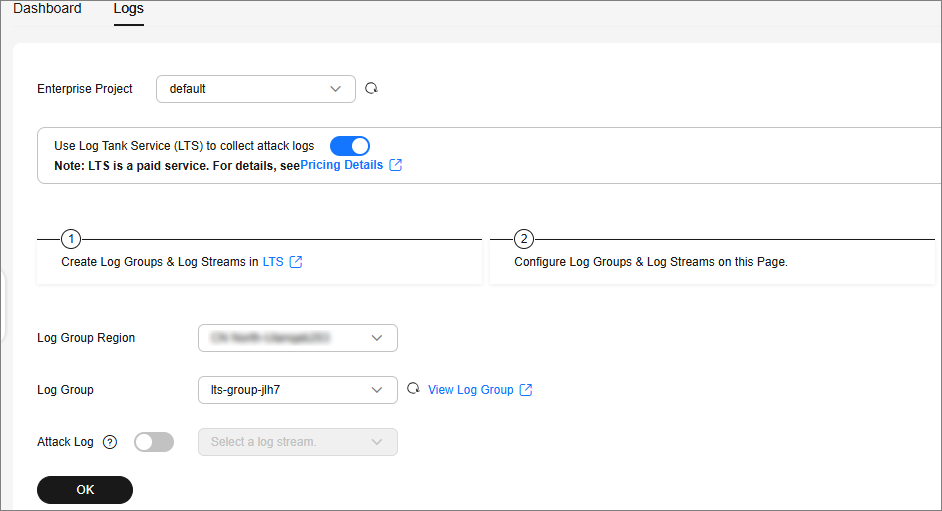Enabling Logging
After you authorize CNAD to access Log Tank Service (LTS), you can use the Anti-DDoS logs recorded by LTS for quick and efficient real-time analysis, device O&M management, and analysis of service trends.
Prerequisites
LTS has been enabled. For details, see Managing Log Groups and Managing Log Streams.
Enabling LTS
- Log in to the AAD console.
- In the navigation pane on the left, choose . The Data Reports page is displayed.
- Click the Logs tab, toggle on
 , and select the log group and log stream. Figure 1 describes related parameters.
, and select the log group and log stream. Figure 1 describes related parameters.
Table 1 Log parameters Parameter
Description
Enterprise Project
Select an enterprise project.
Log Group Region
Select the region to which the log group belongs.
Log Group
Select a log group or click View Log Group to go to the LTS console and create a log group.
Attack Log
After this option is enabled, you can set:
Select a log stream or click View Log Stream to go to the LTS console and create a log stream.
An attack log includes information about event type, protective action, and attack source IP address of each attack.
- Click OK.
You can view protection logs of CNAD on the LTS console.
Log Fields in LTS
This section describes the fields of CNAD logs.
|
Field |
Description |
|---|---|
|
currentConn |
Current Connections |
|
maxInPps |
Peak rate of incoming packets, in pps. |
|
newConn |
New connections |
|
deviceType |
Type of the device that reports logs. The default value is CLEAN, indicating the scrubbing device. |
|
attackTypes |
Attack type. For details, see Table 3. |
|
zoneIP |
Protected IP address. |
|
logType |
Log type. The default value is ip_attack_sum, indicating attack logs. |
|
maxDropPps |
Peak rate of attack packets, in pps. |
|
maxInKbps |
Peak inbound traffic, in kbit/s. |
|
startTime |
Time when the attack starts |
|
endTime |
End time of the attack. If this parameter is left blank, the attack has not ended yet. |
|
maxDropKbps |
Peak attack traffic, in kbps. |
|
attackStatus |
Attack status.
|
|
Value |
Attack Type |
|---|---|
|
0-9 |
User-defined attack type |
|
10 |
SYN flood attack |
|
11 |
Ack flood attack |
|
12 |
SynAck flood attack |
|
13 |
Fin/Rst flood attack |
|
14 |
Concurrent connections exceed the threshold. |
|
15 |
New connections exceed the threshold. |
|
16 |
TCP fragment attack |
|
17 |
TCP fragment bandwidth limit attack |
|
18 |
TCP bandwidth limit attack |
|
19 |
UDP flood attack |
|
20 |
UDP fragment attack |
|
21 |
UDP fragment bandwidth limit attack |
|
22 |
UDP bandwidth limit attack |
|
23 |
ICMP bandwidth limit attack |
|
24 |
Other bandwidth limit attack |
|
25 |
Traffic limiting attack |
|
26 |
HTTPS flood attack |
|
27 |
HTTP flood attack |
|
28 |
Reserved |
|
29 |
DNS query flood attack |
|
30 |
DNS reply flood attack |
|
31 |
SIP flood attack |
|
32 |
Blacklist dropping |
|
33 |
Abnormal HTTP URL behavior |
|
34 |
TCP fragment abnormal dropping traffic attack |
|
35 |
TCP abnormal dropping traffic attack |
|
36 |
UDP fragment abnormal dropping traffic attack |
|
37 |
UDP abnormal dropping traffic attack |
|
38 |
ICMP abnormal attack |
|
39 |
Other abnormal attacks |
|
40 |
Connection flood attack |
|
41 |
Domain name hijacking attack |
|
42 |
DNS poisoning packet attack |
|
43 |
DNS reflection attack |
|
44 |
Oversize DNS packet attack |
|
45 |
Abnormal rate of DNS source requests |
|
46 |
Abnormal rate of DNS source replies |
|
47 |
Abnormal rate of DNS domain name requests |
|
48 |
Abnormal rate of DNS domain name replies |
|
49 |
DNS request packet TTL anomaly |
|
50 |
DNS packet format anomaly |
|
51 |
DNS cache matching and dropping attack |
|
52 |
Port scan attacks |
|
53 |
Abnormal TCP packet flag bit |
|
54 |
BGP attack |
|
55 |
UDP association defense anomaly |
|
56 |
DNS NO such Name |
|
57 |
Other fingerprint attacks |
|
58 |
Zone traffic limit attack |
|
59 |
HTTP slow attacks |
|
60 |
Malware prevention |
|
61 |
Domain name blocking |
|
62 |
Filtering |
|
63 |
Web attack packet capture |
|
64 |
SIP source rate limiting |
Feedback
Was this page helpful?
Provide feedbackThank you very much for your feedback. We will continue working to improve the documentation.See the reply and handling status in My Cloud VOC.
For any further questions, feel free to contact us through the chatbot.
Chatbot






